The guided tour from Warsaw to Treblinka Camp offers a profound and immersive exploration into one of the Holocaust’s most significant sites. Over six hours, visitors will engage with powerful exhibits that illustrate the harrowing history of the over 700,000 Jews and 2,000 Romani people who perished there, while an expert guide provides nuanced storytelling to emphasize remembrance and resilience. With the haunting ruins of the extermination and penal labor camp as the backdrop, this meaningful visit sheds light on a dark chapter of history that demands our utmost attention and reflection.
Key Points

- Guided tour of Treblinka, the second largest extermination camp in Europe, from Warsaw that focuses on the historical significance and immersive experiences.
- Explore the powerful museum exhibits, a miniature model, and the ruins of the Penal Labor Camp to learn about the harrowing history of the camp.
- Hear insightful storytelling from an English-speaking guide about the courageous prisoner uprising in 1943 and the importance of remembering the victims.
- Convenient hotel pickup and drop-off, skip-the-line tickets, and wheelchair accessibility to ensure a comfortable and efficient tour experience.
- Overall tour rating of 4.8 out of 5 based on 12 reviews, highlighting the knowledgeable guide and value for money.
Tour Overview and Pricing
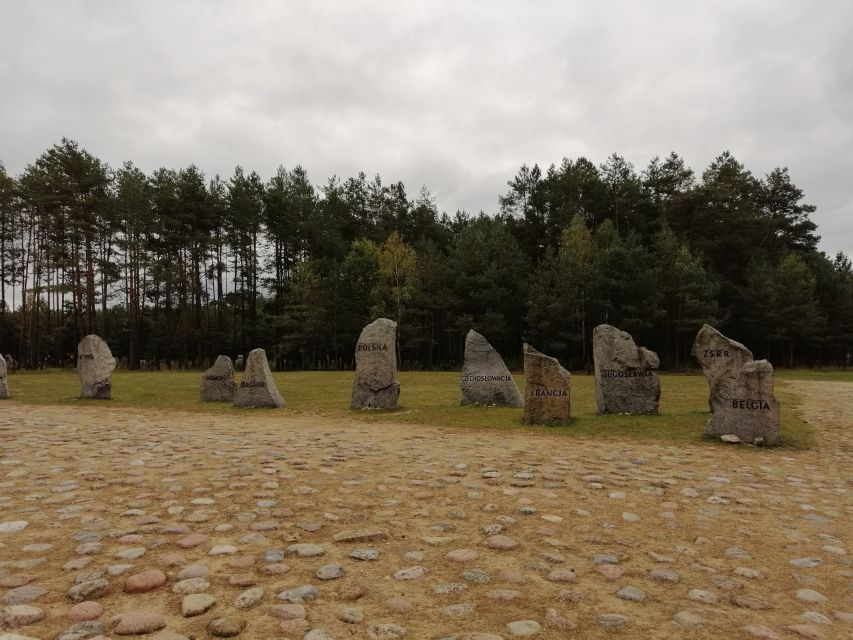
This guided tour of the Treblinka extermination camp offers a comprehensive exploration of one of the most harrowing sites from the Holocaust, with a duration of 6 hours and a cost of £94.74 per person.
The tour provides free cancellation up to 24 hours in advance, allowing for flexibility in planning. Guests can reserve their spot and pay nothing today, taking advantage of the convenient ‘reserve now, pay later‘ option.
With an emphasis on historical significance and a focus on immersive experiences, this tour promises to deliver a powerful and educational journey through one of the darkest chapters of the Second World War.
Loving the local insights? Here are more guided experiences we recommend in Warsaw
Historical Significance of Treblinka
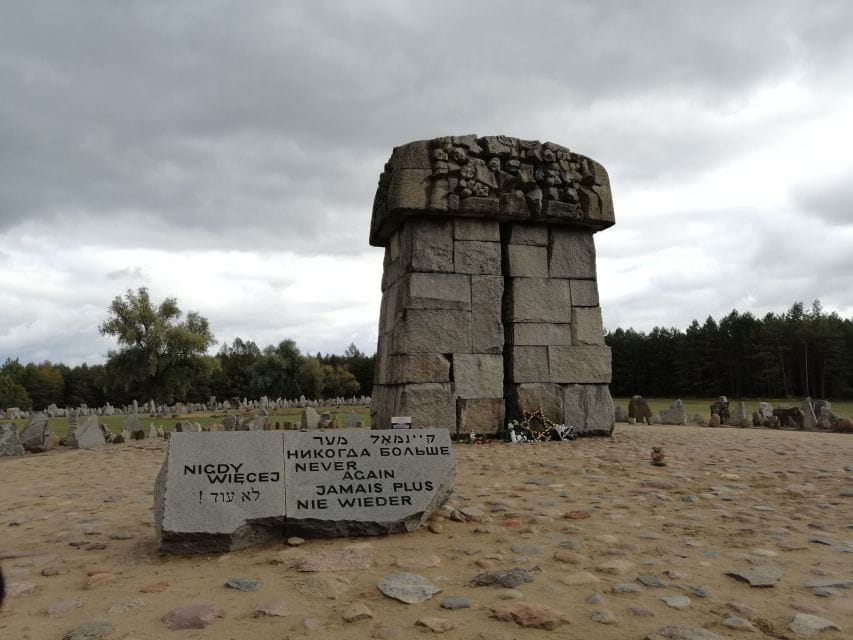
Treblinka was an extermination and penal labor camp operated by Nazi Germany in occupied Poland during World War II, located in a forest northeast of Warsaw and approximately 4 kilometers south of the Treblinka train station.
This camp was part of Operation Reinhard, the deadliest phase of the Final Solution. Between July 1942 and October 1943, an estimated 700,000 to 900,000 Jews and 2,000 Romani people were killed at Treblinka – more Jews than at any other Nazi extermination camp except Auschwitz.
The horrific scale of the atrocities committed here has made Treblinka one of the most notorious symbols of the Holocaust. This tragic history underscores the importance of remembering and honoring the victims of this dark chapter.
Tour Experience and Highlights

Exploring the ruins of the Penal Labor Camp, where approximately 20,000 inmates were held from 1941 to 1944, allows visitors to gain a visceral understanding of the horrific scale of the atrocities committed at Treblinka. The museum’s detailed exhibits further immerse guests in the grim realities of inmate life, complemented by a miniature model that illuminates the camp’s chilling architectural design.
Throughout the tour, an English-speaking guide skillfully brings this somber history to life, recounting the story of the 840 prisoners who heroically rebelled against their fate in August 1943.
The tour experience offers a profound and sobering glimpse into the horrors of the Holocaust:
- Visit the second largest extermination camp in Europe
- Explore the museum’s powerful exhibits and miniature model
- Walk among the ruins of the Penal Labor Camp
- Learn about the courageous prisoner uprising in 1943
Inclusions and Accessibility
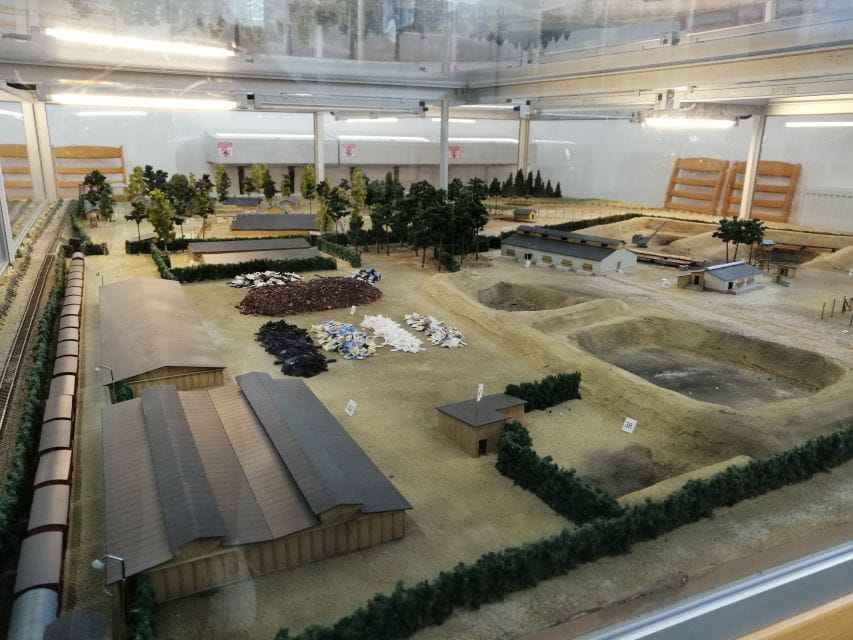
The guided tour of Treblinka Camp includes hotel pickup and drop-off, ensuring a seamless and convenient experience for visitors. An English-speaking driver and guide lead the tour through the camp, providing expert insights and historical context. Guests can also skip the line for efficient entry, maximizing their time on-site. The tour is also designed to be accessible, with wheelchair-friendly accommodations. To make the most of the experience, visitors are recommended to wear comfortable shoes, as the tour involves walking among the camp’s ruins. While food and drinks are not included, the tour provides a comprehensive and immersive exploration of this historically significant site.
| Inclusion | Details |
|---|---|
| Hotel Pickup and Drop-off | Seamless and convenient transportation |
| English-speaking Driver and Guide | Provide expert insights and historical context |
| Skip-the-line Tickets | Efficient entry and maximized on-site time |
| Wheelchair Accessibility | Inclusive of all visitors |
Customer Feedback and Ratings
Travelers who’ve embarked on the guided tour of Treblinka Camp have overwhelmingly praised the experience, with an impressive overall rating of 4.8 out of 5 based on 12 reviews. Guests have highlighted the effectiveness of the driver and guide, as well as the organization of the tour. The transportation has been rated 4.5 out of 5, with reviewers noting the convenience of the hotel pickup and drop-off. Regarding value for money, the tour has received a solid 4 out of 5 rating, reflecting the comprehensive experience and the fair pricing.
Travelers commend the knowledgeable and engaging guide, who brings the harrowing history of Treblinka to life.
The tour’s efficient entry, thanks to the skip-the-line tickets, is praised for minimizing wait times.
Visitors appreciate the wheelchair accessibility, ensuring an inclusive experience.
The well-paced itinerary and the opportunity to explore the museum and camp ruins leave a lasting impression.
- Warsaw In A Nutshell: Walking Tour
- Private Tour: Warsaws Jewish Heritage by Retro Fiat
- Half-Day Warsaw City Sightseeing Bike Tour for Small Group
- Chopin Concerts Every Day at the Fryderyk Concert Hall
- Krakow and Auschwitz Small Group Tour From Warsaw With Lunch
- Warsaw Food Tasting Tour With Delicious Poland
Visiting the Extermination Camp
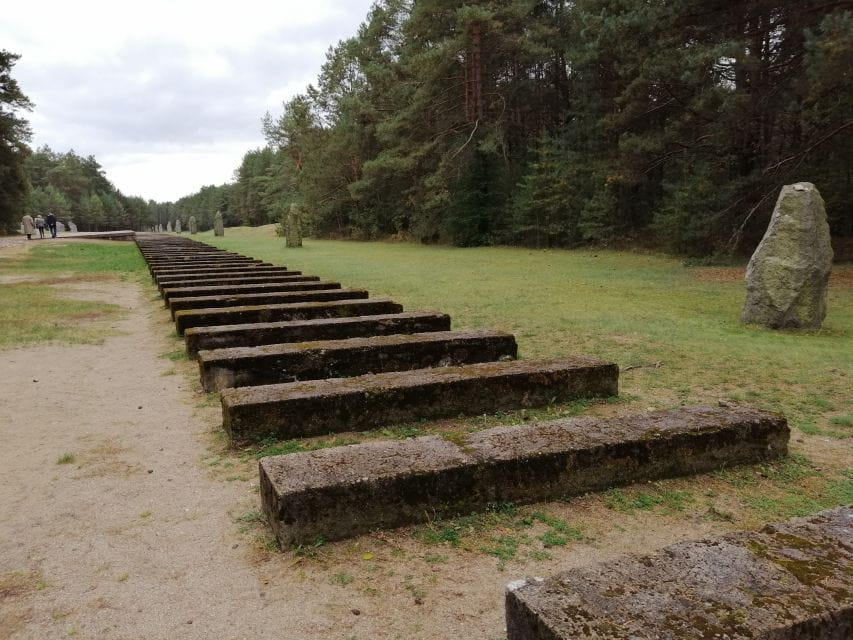
When visitors embark on the guided tour of Treblinka Camp, they’ll find themselves immersed in the harrowing history of one of the deadliest extermination centers operated by the Nazi regime during World War II.
Located in a remote forest northeast of Warsaw, the camp was the site of unimaginable horrors, where an estimated 700,000 to 900,000 Jews and 2,000 Romani people were brutally murdered.
Guests will explore the museum, which provides a chilling account of inmate life and a miniature model of the camp’s architecture.
They’ll also walk among the ruins of the Penal Labor Camp, where thousands of prisoners were held before their tragic fate.
The tour offers a powerful, yet somber, glimpse into this dark chapter of history.
Exploring the Penal Labor Camp
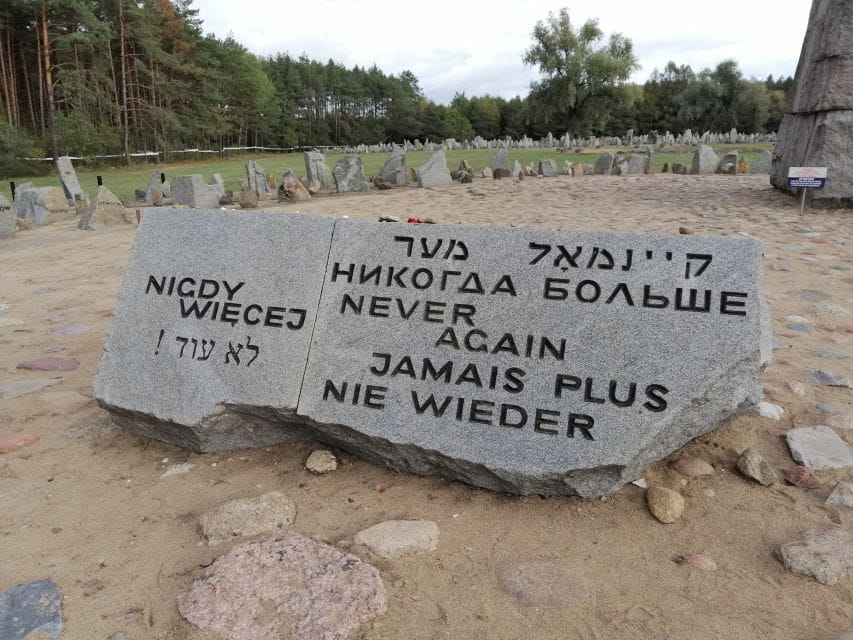
Stepping onto the ruins of the Penal Labor Camp, visitors bear witness to the harrowing remnants of a place where some 20,000 inmates were once held captive before their tragic demise. Scattered concrete foundations and crumbling walls evoke a palpable sense of grief, a tangible reminder of the immense suffering that transpired here.
As they explore the site, visitors gain a deeper understanding of the inhumane conditions and backbreaking labor that the prisoners were forced to endure, shedding light on the grim realities of this dark chapter in history.
The eerie silence that permeates the camp speaks volumes, a haunting testament to the lives lost. Weathered signposts and faded markers hint at the desperate attempts of the inmates to maintain their humanity.
The scale of the camp, once a sprawling complex, is now reduced to ruins, underscoring the magnitude of the tragedy. Visitors leave with a renewed sense of the importance of remembering and honoring the victims of this horrific atrocity.
Commemoration and Remembrance
The Treblinka camp has become a solemn site of commemoration, where visitors pay their respects to the hundreds of thousands of innocent lives cruelly extinguished within its gates.
The memorial complex, erected in the 1960s, features a powerful symbolic monument – a broken Star of David made of concrete and stone. Visitors can walk the path that leads to the mass graves, marked by tall stone obelisks, and reflect on the unimaginable tragedy that unfolded here.
Guided tours provide historical context, sharing stories of resistance and resilience amidst the horrors. Though the scope of the atrocities is difficult to fathom, the memorial serves as a testament to the human spirit and a reminder to never forget.
Frequently Asked Questions
How Long Is the Trip From Warsaw to Treblinka Camp?
The trip from Warsaw to Treblinka Camp takes approximately 1 hour and 15 minutes, covering a distance of around 89 kilometers. This extermination camp, located northeast of the Polish capital, played a tragic role during the Holocaust.
Are There Any Breaks or Stops During the Tour?
The tour does not explicitly mention any scheduled breaks or stops along the way. However, the 6-hour duration suggests there may be opportunities for brief rest periods or photo stops at the discretion of the guide and participants.
Can Personal Cameras Be Used on the Tour?
Visitors are generally allowed to bring and use personal cameras on the tour, providing they do so respectfully and avoid disrupting the solemn atmosphere. However, specific rules may apply, so it’s best to check with the tour operator beforehand.
Is There a Dress Code or Special Requirements for the Tour?
There’s no strict dress code, but visitors should wear comfortable, weather-appropriate clothing and closed-toe shoes. Out of respect, sleeveless shirts, shorts, and revealing outfits are discouraged. The tour site is wheelchair accessible.
Are There Any Shops or Souvenirs Available at the Camp?
There are no shops or souvenirs available at the Treblinka camp. The tour focuses on the historical significance and somber nature of the site, with no commercial elements present out of respect for the victims.
Recap
The Treblinka tour offers a profoundly moving experience, immersing visitors in the dark history of one of the Holocaust’s most significant sites.
Through expert storytelling and powerful exhibits, the tour emphasizes remembrance and resilience, leaving participants with a deeper understanding of this tragic chapter.
A visit to Treblinka’s haunting ruins is a solemn yet meaningful way to honor the memory of the over 700,000 lives lost.
More Guided Tours in Warsaw
More Tours in Warsaw
More Tour Reviews in Warsaw
Not for you? Here's more things to do in Warsaw we have recnetly reviewed
- Warsaw: Cathedral Organ Concerts and tour of the crypts
- Walking Tour of Warsaw: Old Town Tour – 2-Hours of Magic!
- Warsaw: Skip-the-Line Entry to Room 13 Club + Welcome Shot
- Warsaw: National Museum Private Guided Tour & Tickets
- Warsaw Historic Heart Walking Tour – must-see & hidden gems
- Warsaw Old Town: Spy-Themed Walk & Game with Host/Guide
- 2 hour: Palace of Culture & Science Guided Tour in English
- azienki Park and Palace Warsaw Private Tour with Tickets
- Warsaw: Pub Crawl with Optional 1-Hour Open Bar
- Warsaw: Majdanek Concentration Camp, Lublin Day Trip by Car
- Warsaw: Helicopter Private Tour
- Warsaw Praga — where modern, traditional, and bohemian meet
